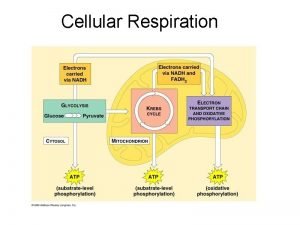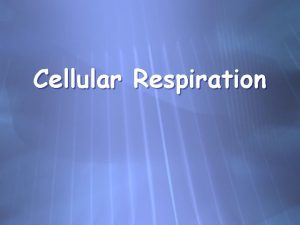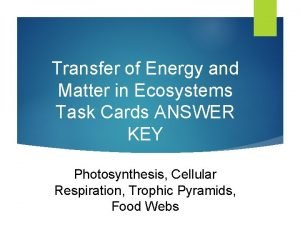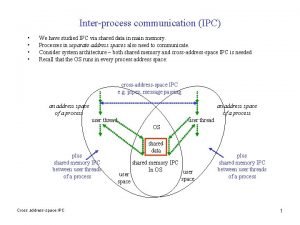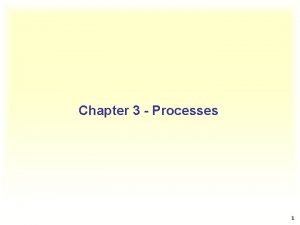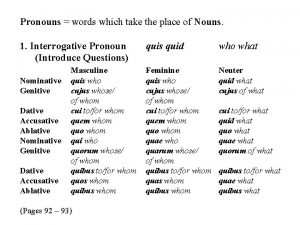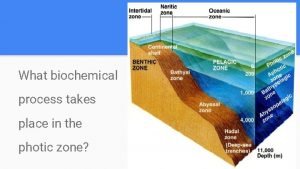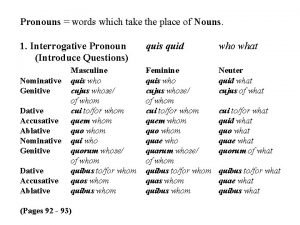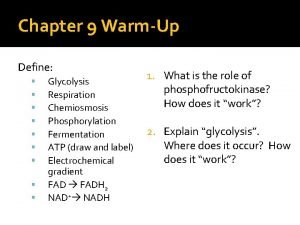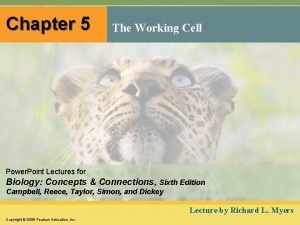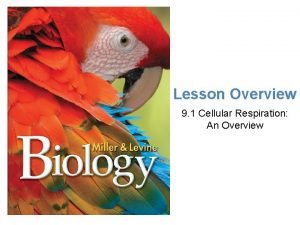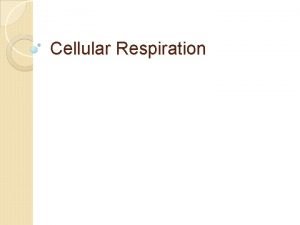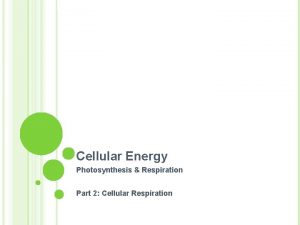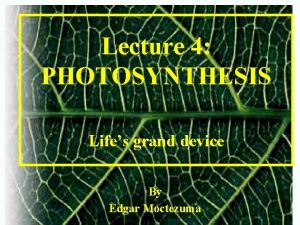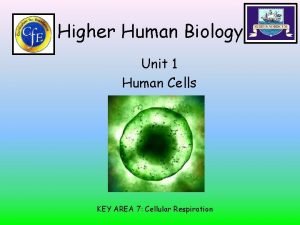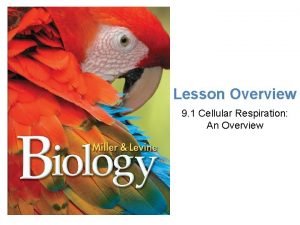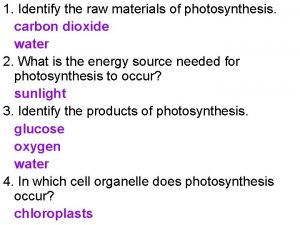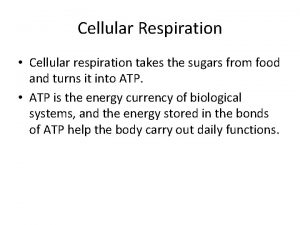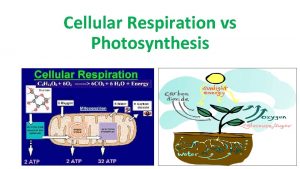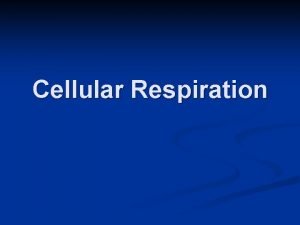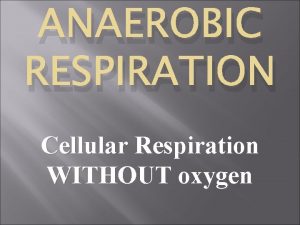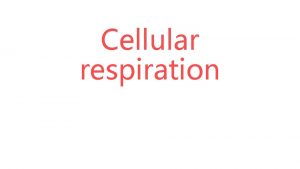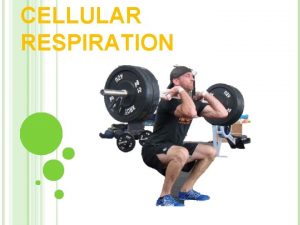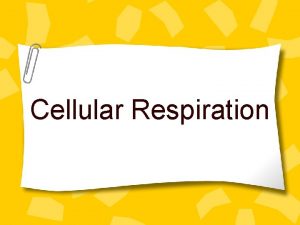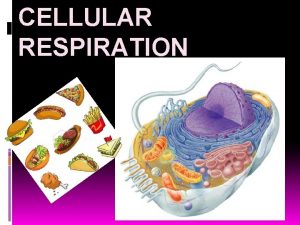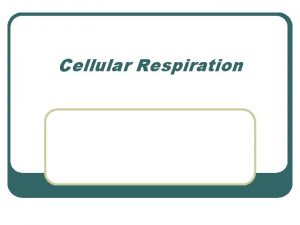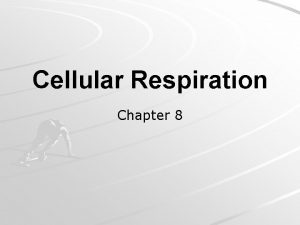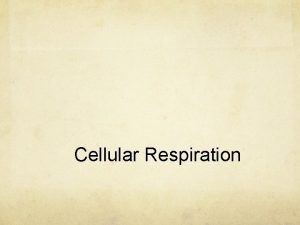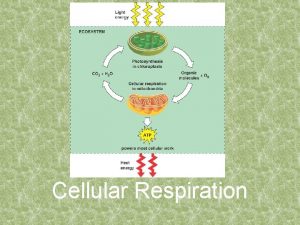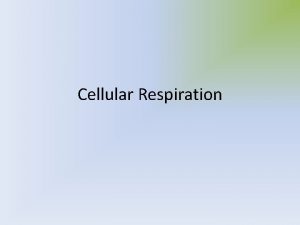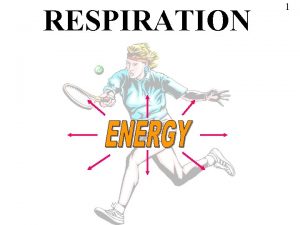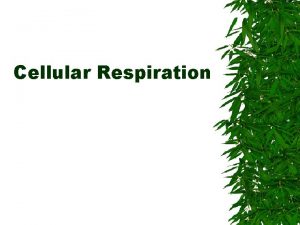Cellular Respiration Cellular Respiration Cellular Respiration takes place







































- Slides: 39

Cellular Respiration

Cellular Respiration: • Cellular Respiration takes place in both plant and animal cells. • It really takes place in nearly all cells. • Sometimes people think photosynthesis only takes place in plant cells and respiration only takes place in animal cells and this is not correct.

Cellular Respiration: • Cellular respiration is the process that takes the chemical energy from "food" molecules and releases it so that it can be captured (in part) in the form of ATP through phosphorylation. Cells can use carbohydrates, fats, and proteins as fuels for cellular respiration, however, glucose is most commonly used.


Cellular Respiration: • Cellular respiration occurs in both the cytoplasm and mitochondria.

2 Types of Cellular Respiration: ¶ Aerobic Respiration: with oxygen, i. Two Stages of aerobic respiration: Glycolysis: the splitting of glucose into 2 molecules of pyruvic acid (3 -carbon molecule – also called pyruvate) and the net release of 2 ATP (converts ADP and P into ATP - this is called substrate level phosphorylation) and 2 NADH molecules. • Takes place in the cytoplasm and has no oxygen requirement. • Occurs in nearly all organisms and probably evolved from ancient prokaryotes before oxygen was available.

Glycolysis in Detail Glycolysis generates ATP by substrate-level phosphorylation. Enzyme ADP Substrate Figure 9. 7 P + Product ATP

Glycolysis:


Glycolysis to the Citric Acid (Krebs) Cycle Before the citric acid cycle can begin Pyruvate must first be converted to acetyl Co. A, which links the cycle to glycolysis CYTOSOL MITOCHONDRION NAD+ NADH + H+ O– S Co. A C O 2 C C O O 1 3 CH 3 Pyruvate Transport protein Figure 9. 10 CH 3 Acetyle Co. A CO 2 Coenzyme A

2 Types of Cellular Respiration: ¶Aerobic Respiration: with oxygen, i. Two Stages of aerobic respiration: Break down (oxidizing) the pyruvic acid molecules using the Krebs Cycle and Electron Transport Chain to get CO 2, H 2 O and 36 ATP molecules.

The Krebs Cycle: • Takes place in the matrix of the mitochondria.

The Krebs Cycle: A. Citric Acid Production: • As pyruvic acid enters the mitochondrial matrix, a carbon is removed, forming CO 2, and electrons are removed, changing NAD+ to NADH. • Coenzyme A joins the 2 -carbon molecule, forming acetyl-Co. A. Acetyl-Co. A then adds the 2 -carbon acetyl group to a 4 carbon compound, forming citric acid.

Tribute to Hans Adolf Krebs

The Krebs Cycle: B. Energy Extraction: Citric acid is broken down into a 5 -carbon compound, then into a 4 -carbon compound. Along the way, two more molecules of CO 2 are released, and electrons join NAD+ and FAD, forming NADH and FADH 2. In addition, one molecule of ATP is generated. The energy tally from one molecule of pyruvic acid is 4 NADH, 1 FADH 2, and 1 molecule of ATP (2 x - since two pyruvic acid molecules enter the Krebs Cycle).

The Krebs Cycle (in more detail):

The Krebs Cycle (in more detail):

Electron Transport System: • • • Takes place in the inner mitochondrial membrane. The electron transport chain (ETC) consists of a series of molecules, mostly proteins, embedded in the inner mitochondrial membrane. Electrons lose energy as they pass from one coenzyme to the next. The final electron acceptor is oxygen. This is why it is aerobic. This energy is converted into ATP by chemiosmosis (hydrogen ions pass through the membrane through the protein ATP synthase, which converts ADP and P into ATP). This is called oxidative phosphorylation. This produces 90% of ATP produced by Aerobic Cellular Respiration.


Electron Transport System: • The electron transport chain allows the release of the large amount of chemical energy stored in reduced NAD+ (NADH) and reduced FAD (FADH 2). The energy released is captured in the form of ATP (3 ATP per NADH and 2 ATP per FADH 2). NADH + H+ + 3 ADP + 3 Pi + 1/2 O 2 → NAD+ + H 2 O + 3 ATP FADH 2 + 2 ADP + 2 Pi + 1/2 O 2 → FAD+ + H 2 O + 2 ATP

Electron Transport System:

Summary of ATP molecules produced by Aerobic Cellular Respiration: 1. Glycolysis: Glucose = 2 pyruvic acids + 2 NADH + 2 ATP 2. Krebs Cycle: 2 pyruvic acids = 8 NADH and 2 FADH 2 + 2 ATP 3. Electron Transport Chain: 10 NADH = 30 ATP 2 FADH 2 = 4 ATP Total of 36 ATP molecules (potentially).

Aerobic Respiration Equation: C 6 H 12 O 6 + 6 O 2 + 6 H 2 O 36 ATP (Energy) + 6 CO 2 + 12 H 2 O

A Simple Diagram of Cellular Respiration:


ATP Yield During Aerobic Cellular Respiration:

ATP Yield During Aerobic Cellular Respiration:

2 Types of Cellular Respiration: ·Anaerobic Respiration: without oxygen. Takes place in the cytoplasm when oxygen is not present in the cell. There are two types of anaerobic respiration:

2 Types of Cellular Respiration: ¬Alcohol Fermentation: The glucose molecules are converted to ethyl alcohol and 4 ATP molecules. Glucose (Glycolysis) 2 Pyruvates 2 Acetaldehydes + 2 CO 2 2 Ethanols

2 Types of Cellular Respiration: Lactic Acid Fermentation: The glucose molecules are converted to lactic acid and 4 ATP molecules. This leads to muscle fatigue, soreness and cramps. Glucose (Glycolysis) 2 Pyruvates 2 Lactates (lactate is eventually transported by blood to the liver and converted back to pyruvate)

A Detailed Diagram of Anaerobic Cellular Respiration:

Comparison of the different Types of Cellular Respiration: Aerobic Cellular Respiration Lactic Acid Fermentation Ethyl Alcohol Fermentation Glucose Glycolysis (pyruvic acid) CO 2 and H 2 O + 36 ATP Glucose Glycolysis (pyruvic acid) Lactic Acid + 2 ATP Glucose Glycolysis (pyruvic acid) Alcohol and CO 2 + 2 ATP

2 Types of Cellular Respiration: • Obviously aerobic respiration is much more effective than anaerobic respiration.

Energy and Exercise: • Muscle cells normally contain small amounts of ATP for a few seconds of intense activity. • Quick Energy: Once this ATP is gone, muscle cells produce most of their ATP by lactic acid fermentation (anaerobic). But this can only last for about 90 seconds. Afterwards, this lactic acid can be removed with extra oxygen (why you breathe hard after short intense exercise).

Energy and Exercise: • Long-Term Energy: for exercise longer than 90 seconds, your body must use aerobic cellular respiration to generate a continuous supply of ATP molecules. Your body stores energy in muscles and other tissues in the form of the carbohydrate glycogen. After 15 to 20 minutes of exercise you begin to run out of glycogen and your body begins to break down fats and eventually protein for energy.

Cellular Respiration: • Remember that cellular respiration is the process that takes the chemical energy from "food" molecules to form ATPs. • Cells can use carbohydrates, fats, and proteins as fuels for cellular respiration, however, glucose is most commonly used.


Energy in Cells:

Energy in Cells:
 Krebs cycle occurs in
Krebs cycle occurs in Where does cellular respiration take place
Where does cellular respiration take place Where does cellular respiration take place
Where does cellular respiration take place Physical development
Physical development Conflict takes place outside of the body.
Conflict takes place outside of the body. The story takes place in
The story takes place in Random orientation of homologous chromosomes
Random orientation of homologous chromosomes Advantages and disadvantages of suspension therapy
Advantages and disadvantages of suspension therapy Interest rate parity arbitrage
Interest rate parity arbitrage 8086 microprocessor instruction set
8086 microprocessor instruction set Ratatouille gusteau book
Ratatouille gusteau book Interprocessor communication takes place via
Interprocessor communication takes place via Takes the place of a noun or noun phrase
Takes the place of a noun or noun phrase Story takes place
Story takes place Beowulf is a(n) epic poem.
Beowulf is a(n) epic poem. How communication takes place
How communication takes place Green plants make their own food by photosynthesis
Green plants make their own food by photosynthesis What is electric force
What is electric force Protagonist examples
Protagonist examples Communication takes place between
Communication takes place between A word that takes the place of a noun
A word that takes the place of a noun Conflict literary definition
Conflict literary definition Photolysis of water
Photolysis of water Which process takes place
Which process takes place Battling over clayoquot big trees worksheet answers
Battling over clayoquot big trees worksheet answers Internal sorting takes place in
Internal sorting takes place in Are words that take the place of a noun
Are words that take the place of a noun The characters struggle takes place in his/her own mind
The characters struggle takes place in his/her own mind The stages of cellular respiration
The stages of cellular respiration Chapter 5 the working cell
Chapter 5 the working cell Gylcolysis
Gylcolysis Where in the cell does cellular respiration occur
Where in the cell does cellular respiration occur Cellular respiration organelle
Cellular respiration organelle Overview of cellular respiration
Overview of cellular respiration Cellular respiration equation
Cellular respiration equation Higher human biology cellular respiration
Higher human biology cellular respiration Cellular respiration
Cellular respiration Cellular respiration
Cellular respiration Cellular respiration reactants
Cellular respiration reactants Raw materials for photosynthesis
Raw materials for photosynthesis
